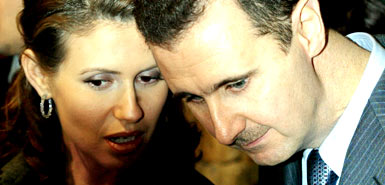
Bashar al-Assad’s regime finds itself dealing with an interesting mix of press in the lame duck days.
Today’s papers report re-established intelligence ties between British and Syrian agencies; they come as British FM David Miliband makes a landmark visit to Damascus, in which he met with President Assad. The meeting of the pair — as opposed to Miliband only meeting with his counterpart Walid Muallim — speaks volumes to Syria’s interest in re-establishing ties on a grand scale. And in setting up a meeting between Assad and Brown.
The meeting would be the first between leaders of the two states since Assad embarrassed Blair on the issue of afghani civilian deaths at a 2001 joint press conference in Damascus.
But the media swing is juxtaposed with today’s release — though there were early leaks to the press — of an IAEA report suggesting uranium was found at the Al-Kibar site. It’s the location Israel mysteriously bombed in September 2007. The attack set off wild speculation, Israeli intelligence largely remaining silent, though US officials leaked intelligence suggesting the site was a nuclear reactor built with North Korean assistance. Pictures eventually came forward, in addition to claims that Israeli intelligence had infiltrated the site to retrieve evidence, though no conclusive verdicts were reached in policy nor nuclear proliferation spheres.
Today, Muallim suggested that the uranium likely came from the munitions dropped by Israel. A claim, that while clever, doesn’t seem instantly plausible. The uranium, which is not highly enriched, was also chemically processed and not simply naturally occurring in local soil.
The report, while clearly inconclusive on the issue, is a reminder to the Syrian regime of the distance it must go before it will be accepted into international society.
–– Brian Till

